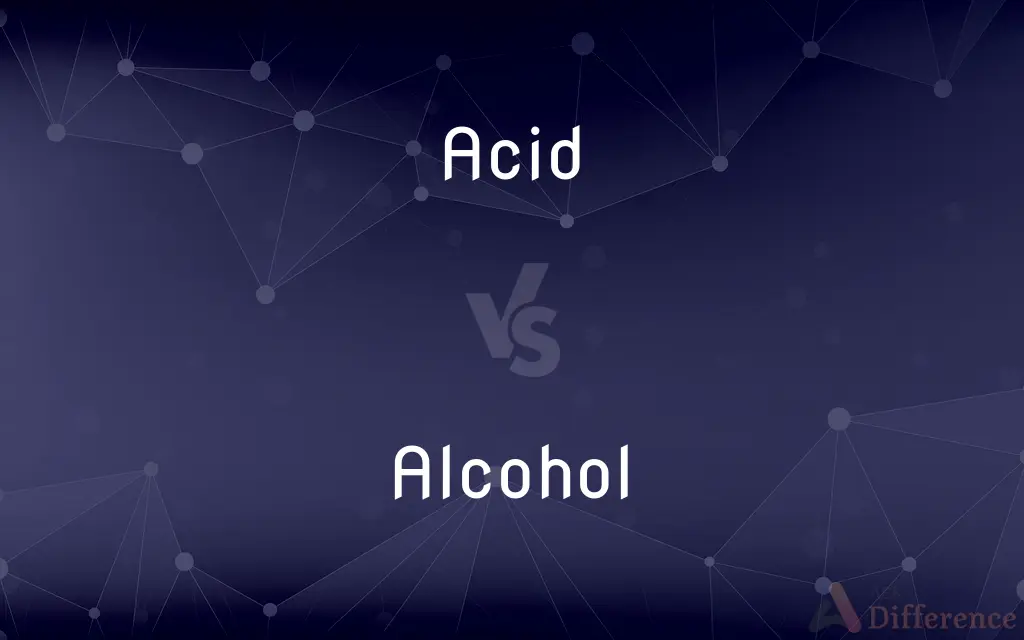Acid vs. Alcohol — What's the Difference?
By Fiza Rafique & Maham Liaqat — Updated on April 3, 2024
Acid is substance that donates hydrogen ions or accepts an electron pair in reactions, characterized by sour taste and pH below 7. Alcohol is organic compound with hydroxyl group attached to carbon atom, known for its use in beverages, solvents, and fuel.

Difference Between Acid and Alcohol
Table of Contents
ADVERTISEMENT
Key Differences
Acids are chemical substances that, in aqueous solutions, release hydrogen ions (H+), contributing to their sour taste and corrosive properties. In contrast, alcohols are characterized by the presence of one or more hydroxyl (-OH) groups attached to a carbon atom, making them key components in various industrial and consumable products. While acids play crucial roles in chemical reactions by acting as proton donors or acceptors, alcohols are versatile as solvents, fuels, and in the synthesis of other compounds due to their reactivity.
The pH scale, which measures the acidity or alkalinity of a solution, is a key differentiator between acids and alcohols. Acids typically have a pH below 7, indicating a higher concentration of hydrogen ions, whereas alcohols do not directly affect the pH of a solution in the same way acids do, since their hydroxyl group does not readily release hydrogen ions.
From a functional perspective, acids are essential in the biochemical processes of organisms and industrial chemical reactions, including the manufacturing of plastics, pharmaceuticals, and fertilizers. Alcohols, on the other hand, find their use predominantly as antiseptics, beverages, and solvents, with ethanol being the most widely used alcohol in drinks and biofuels.
In terms of safety and handling, acids require careful storage and handling due to their corrosive nature and potential to cause chemical burns. Alcohols, while flammable and toxic in high concentrations, are generally less hazardous in terms of corrosion but pose significant risks related to ingestion, inhalation, and fire.
Environmentally, both acids and alcohols can have detrimental effects if not managed properly. Acidic compounds can lead to acid rain and soil acidification, harming ecosystems, whereas alcohols, especially when spilled, can contribute to water and soil pollution, affecting aquatic life and water quality.
ADVERTISEMENT
Comparison Chart
Basic Definition
Substances that donate H+ ions or accept electron pairs in reactions.
Organic compounds with one or more hydroxyl (-OH) groups.
Key Features
Sour taste, pH below 7, corrosive.
Flammable, used in beverages, solvents, and as fuel.
Role in Reactions
Act as proton donors or acceptors.
Used as solvents, in synthesis, and as fuels.
PH Influence
Typically have a pH below 7.
Do not directly affect pH in the same manner as acids.
Functional Uses
Important in biochemical processes and manufacturing.
Used in beverages, as antiseptics, and in industrial applications.
Safety and Handling
Corrosive, can cause burns, requires careful handling.
Flammable, toxic in high concentrations, less corrosive.
Environmental Impact
Can contribute to acid rain and soil acidification.
Risk of water and soil pollution if mishandled.
Compare with Definitions
Acid
Compounds that can act as proton donors in chemical reactions.
Hydrochloric acid is used in the industrial cleaning process.
Alcohol
Used widely as solvents in the pharmaceutical industry.
Isopropyl alcohol is used to clean medical devices.
Acid
A substance that releases hydrogen ions in solution, exhibiting a sour taste.
Citric acid gives lemons their sour flavor.
Alcohol
Can be toxic when ingested in large quantities.
Methanol poisoning can lead to blindness or death.
Acid
Characterized by a pH lower than 7 in aqueous solutions.
The acid in the vinegar made the pH of the solution drop.
Alcohol
Alcohols have antiseptic properties, useful in sanitizers.
Hand sanitizers often contain ethanol or isopropanol.
Acid
Acids are crucial in the production of fertilizers and plastics.
Sulfuric acid is essential in the manufacture of fertilizers.
Alcohol
Organic compounds with one or more hydroxyl groups.
Ethanol is commonly used in alcoholic beverages.
Acid
Their corrosive nature requires careful storage and handling.
Safety gloves are necessary when handling strong acids.
Alcohol
Flammable substances, serving as a fuel source.
Ethanol is blended with gasoline to produce a cleaner-burning fuel.
Acid
An acid is a molecule or ion capable of either donating a proton (i.e., hydrogen ion, H+), known as a Brønsted–Lowry acid, or, capable of forming a covalent bond with an electron pair, known as a Lewis acid.The first category of acids are the proton donors, or Brønsted–Lowry acids. In the special case of aqueous solutions, proton donors form the hydronium ion H3O+ and are known as Arrhenius acids.
Alcohol
In chemistry, alcohol is an organic compound that carries at least one hydroxyl functional group (−OH) bound to a saturated carbon atom. The term alcohol originally referred to the primary alcohol ethanol (ethyl alcohol), which is used as a drug and is the main alcohol present in alcoholic drinks.
Acid
A substance with particular chemical properties including turning litmus red, neutralizing alkalis, and dissolving some metals; typically, a corrosive or sour-tasting liquid of this kind.
Traces of acid
Trees were exposed to mixtures of heavy metals, acids, and overdoses of nutrients
Alcohol
A colourless volatile flammable liquid which is produced by the natural fermentation of sugars and is the intoxicating constituent of wine, beer, spirits, and other drinks, and is also used as an industrial solvent and as fuel
The use of petrol containing alcohol
It is an offence to drive if you have more than 80 mg of alcohol per 100 ml of blood
Acid
A molecule or other species which can donate a proton or accept an electron pair in reactions.
Alcohol
Any of a series of hydroxyl compounds, the simplest of which are derived from saturated hydrocarbons, have the general formula CnH2n+1OH, and include ethanol and methanol.
Acid
The drug LSD
A bad acid trip
She didn't have a clue the sweet had acid in it
Alcohol
A colorless volatile flammable liquid, C2H5OH, synthesized or obtained by fermentation of sugars and starches and widely used, either pure or denatured, as a solvent and in drugs, cleaning solutions, explosives, and intoxicating beverages. Also called ethanol, ethyl alcohol, grain alcohol.
Acid
Containing acid or having the properties of an acid; having a pH of less than 7.
Acid soils
Alcohol
Intoxicating beverages containing ethanol considered as a group
The national consumption of alcohol.
Acid
Sharp-tasting or sour
Acid fruit
Alcohol
Any of a class of organic compounds (such as ethanol) containing a hydroxyl functional group (-OH).
Acid
(of rock, especially lava) containing a relatively high proportion of silica
The magma may start off fairly basic and end up at the close of the eruption much more acid
Alcohol
(colloquial) Ethanol.
Acid
Any of a class of substances whose aqueous solutions are characterized by a sour taste, the ability to turn blue litmus red, and the ability to react with bases and certain metals to form salts.
Alcohol
(uncountable) Beverages containing ethanol, collectively.
Acid
A substance that yields hydrogen ions when dissolved in water.
Alcohol
(obsolete) Any very fine powder.
Acid
A substance that can act as a proton donor.
Alcohol
An impalpable powder.
Acid
A substance that can accept a pair of electrons to form a covalent bond.
Alcohol
The fluid essence or pure spirit obtained by distillation.
Acid
A substance having a sour taste.
Alcohol
Pure spirit of wine; pure or highly rectified spirit (called also ethyl alcohol or ethanol, CH3.CH2.OH); the spirituous or intoxicating element of fermented or distilled liquors, or more loosely a liquid containing it in considerable quantity. It is extracted by simple distillation from various vegetable juices and infusions of a saccharine nature, which have undergone vinous fermentation.
Acid
The quality of being sarcastic, bitter, or scornful
Wrote with acid about her first marriage.
Alcohol
A class of compounds analogous to vinic alcohol in constitution. Chemically speaking, they are hydroxides of certain organic radicals; as, the radical ethyl forms common or ethyl alcohol (C2H5.OH); methyl forms methyl alcohol (CH3.OH) or wood spirit; amyl forms amyl alcohol (C5H11.OH) or fusel oil, etc.
Acid
(Slang) See LSD1.
Alcohol
A liquor or brew containing alcohol as the active agent;
Alcohol (or drink) ruined him
Acid
Of, relating to, or containing an acid.
Alcohol
Any of a series of volatile hydroxyl compounds that are made from hydrocarbons by distillation
Acid
Having a high concentration of acid.
Acid
Having the characteristics of an acid.
Acid
Having a pH of less than 7.
Acid
Having a relatively high concentration of hydrogen ions.
Acid
(Geology) Containing a large proportion of silica
Acid rocks.
Acid
Having a sour taste.
Acid
Biting, sarcastic, or scornful
An acid wit.
An acid tone of voice.
Acid
Sour, sharp, or biting to the taste; tart; having the taste of vinegar.
Acid fruits or liquors
Acid
(figuratively) Sour-tempered.
Acid
Of or pertaining to an acid; acidic.
Acid
(music) Denoting a musical genre that is a distortion (as if hallucinogenic) of an existing genre, as in acid house, acid jazz, acid rock.
Acid
A sour substance.
Acid
(chemistry)
Acid
Any compound which yields H+ ions (protons) when dissolved in water; an Arrhenius acid.
Acid
Any compound that easily donates protons to a base; a Brønsted acid.
Acid
Any compound that can accept a pair of electrons to form a covalent bond; a Lewis acid.
Acid
Any corrosive substance.
Acid
LSD, lysergic acid diethylamide.
Acid
Sour, sharp, or biting to the taste; tart; having the taste of vinegar: as, acid fruits or liquors. Also fig.: Sour-tempered.
He was stern and his face as acid as ever.
Acid
Of or pertaining to an acid; as, acid reaction.
Acid
A sour substance.
Acid
One of a class of compounds, generally but not always distinguished by their sour taste, solubility in water, and reddening of vegetable blue or violet colors. They are also characterized by the power of destroying the distinctive properties of alkalies or bases, combining with them to form salts, at the same time losing their own peculiar properties. They all contain hydrogen, united with a more negative element or radical, either alone, or more generally with oxygen, and take their names from this negative element or radical. Those which contain no oxygen are sometimes called hydracids in distinction from the others which are called oxygen acids or oxacids.
Acid
Any of various water-soluble compounds having a sour taste and capable of turning litmus red and reacting with a base to form a salt
Acid
Street name for lysergic acid diethylamide
Acid
Harsh or corrosive in tone;
An acerbic tone piercing otherwise flowery prose
A barrage of acid comments
Her acrid remarks make her many enemies
Bitter words
Blistering criticism
Caustic jokes about political assassination, talk-show hosts and medical ethics
A sulfurous denunciation
Acid
Containing acid;
An acid taste
Common Curiosities
What distinguishes an acid from an alcohol?
Acids release hydrogen ions in solutions, with a sour taste and corrosive nature, while alcohols contain a hydroxyl group, are flammable, and serve various uses including in beverages and as solvents.
Can alcohols act as acids?
Some alcohols can exhibit acidic properties under specific conditions due to the presence of the hydroxyl group, but they are generally considered weak acids.
Why is ethanol used in beverages, and is it different from other alcohols?
Ethanol is safe for consumption in controlled quantities, unlike methanol, which is toxic. Its chemical structure allows it to be metabolized by the human body.
What are the safety concerns associated with acids and alcohols?
Acids require careful handling due to their corrosive nature and potential for chemical burns, while alcohols are flammable and can be toxic if ingested in large amounts.
Are all acids harmful or dangerous?
Not all acids are harmful; their danger level depends on concentration and type. Weak acids like acetic acid (vinegar) are commonly used and safe under normal conditions.
Can alcohol be converted into an acid?
Yes, through oxidation processes, alcohols can be converted into acids (e.g., ethanol to acetic acid).
How do acids and alcohols impact the environment?
Acids can contribute to environmental issues like acid rain and soil acidification, whereas alcohols, particularly when spilled, pose risks to water quality and aquatic life.
What is the pH range of alcohols, and how does it compare to acids?
Alcohols generally do not have a pH range as they do not ionize in water like acids, which have a pH below 7, indicating acidity.
How do industries neutralize acids before disposal?
Industries often use neutralization processes, adding a base to an acid to form water and a salt, minimizing environmental impact.
Why are acids important in industrial processes?
Acids are crucial in industrial processes for their role in chemical synthesis, including the production of plastics, fertilizers, and pharmaceuticals, due to their reactivity.
What are the common uses of alcohols in everyday life?
Alcohols are used in beverages, cleaning products, hand sanitizers, cosmetics, and as fuel additives.
What environmental precautions should be taken when handling alcohols?
Precautions include proper storage, avoiding spills to prevent water and soil pollution, and using spill containment measures.
How do the chemical structures of acids and alcohols differ?
Acids contain hydrogen ions that can be donated in reactions, while alcohols have a hydroxyl group (-OH) bonded to a carbon atom, defining their chemical and physical properties.
What role do acids play in the human body?
Acids play crucial roles in digestion (stomach acid) and metabolism (amino acids, fatty acids), essential for nutrient breakdown and energy production.
Can acids and alcohols react together, and what are the products?
Acids can react with alcohols in a process called esterification, producing esters (used in fragrances and flavors) and water.
Share Your Discovery

Previous Comparison
Molding vs. Moulding
Next Comparison
Gamy vs. GameyAuthor Spotlight
Written by
Fiza RafiqueFiza Rafique is a skilled content writer at AskDifference.com, where she meticulously refines and enhances written pieces. Drawing from her vast editorial expertise, Fiza ensures clarity, accuracy, and precision in every article. Passionate about language, she continually seeks to elevate the quality of content for readers worldwide.
Co-written by
Maham Liaqat













































